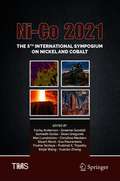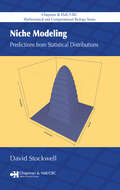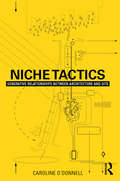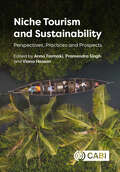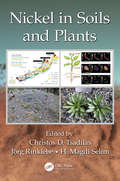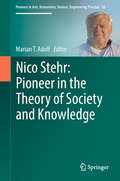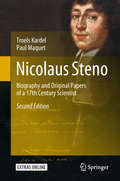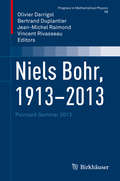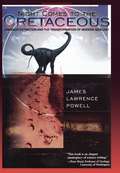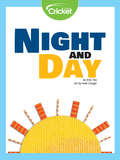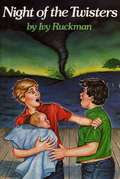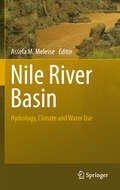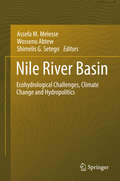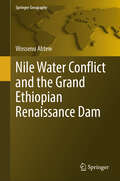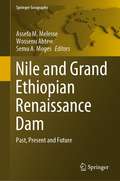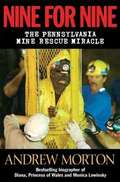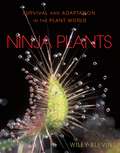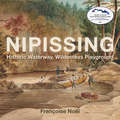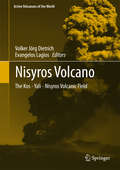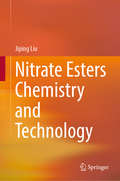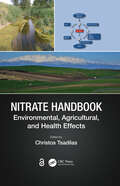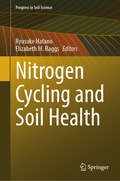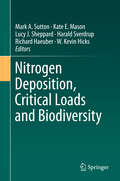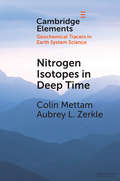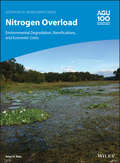- Table View
- List View
Ni-Co 2021: The 5th International Symposium on Nickel and Cobalt (The Minerals, Metals & Materials Series)
by Corby Anderson Dean Gregurek Shijie Wang Fiseha Tesfaye Graeme Goodall Christina Meskers Sumedh Gostu Mari Lundström Stuart Nicol Esa Peuraniemi Prabhat K. Tripathy Yuanbo ZhangIn this volume, operators, engineers, and researchers present information about all aspects of current processing technologies for nickel and cobalt, as well as emerging technologies for both metals. Contributions from industry and academia encompass metallurgical aspects of metals commonly associated with nickel and cobalt, such as copper and platinum group metals (PGMs). Specific focus areas of the collection include, but are not limited to mineral processing, metallurgy of nickel and cobalt ores, battery materials, recycling, recovery of associated byproducts and PGMs, and sulfide and laterite processing.
Niche Modeling: Predictions from Statistical Distributions
by David StockwellUsing theory, applications, and examples of inferences, Niche Modeling: Predictions from Statistical Distributions demonstrates how to conduct and evaluate niche modeling projects in any area of application. It features a series of theoretical and practical exercises for developing and evaluating niche models using the R statistics language. The au
Niche Tactics: Generative Relationships Between Architecture and Site
by Caroline O'DonnellNiche Tactics aligns architecture's relationship with site with its ecological analogue: the relationship between an organism and its environment.Bracketed between texts on giraffe morphology, ecological perception, ugliness, and hopeful monsters, architectural case studies investigate historical moments when relationships between architecture and site were productively intertwined, from the anomalous city designs of Francesco de Marchi in the sixteenth century to Le Corbusier’s near eradication of context in his Plan Voisin in the twentieth century to the more recent contextualist movements. Extensively illustrated with 140 drawings and photographs, Niche Tactics considers how attention to site might create a generative language for architecture today.
Niche Tourism and Sustainability: Perspectives, Practices and Prospects
by Anna Farmaki, Pramendra Singh & Viana HassanNiche tourism, also known as special interest tourism, refers to specialized tourism products offered to a small group of tourists. Examples include ecotourism, rural tourism, birdwatching tourism, dark tourism and motorcycle tourism. Regarded as the antidote to mass tourism, niche tourism has become particularly popular in recent years as a tourism developmental option that can address the problems caused by mass tourism including overtourism. It is commonly acknowledged that niche tourism fosters responsible tourism practices, minimizes negative tourism impacts and helps preserve the environment and culture of destinations; thereby, promoting sustainability in tourism. Likewise, niche tourism seems to be better equipped to address the needs and preferences of today's sophisticated and diverse tourist market. Despite these advantages, niche tourism development faces challenges such as overlap with mass tourism due to growing numbers of visitors, promotion of products that are not environmentally friendly and limited economic benefits being directed to the local community. This book is a collection of 12 conceptual and empirical chapters presenting niche tourism cases from around the world. It examines tourist behaviour and experiences, resident perspectives, implementation practices and future prospects, and contributes to the debate on tourism development and sustainability.
Nickel in Soils and Plants (Advances in Trace Elements in the Environment)
by Christos Tsadilas Jörg Rinklebe Magdi SelimSoils with high Ni contents occur in several parts of the world, especially in areas with ultramafic rocks which cause serious environmental impacts. This book aims to extend the knowledge on the risks and problems caused by elevated Ni contents and to cover the existing gaps on issues related to various aspects and consequences of high Ni contents in soils and plants. Nickel in Soils and Plants brings together discussions on Ni as a trace element and as a micronutrient essential for plant growth and its role in plant physiology. It analyzes the biogeochemistry of Ni at the soil plant interface, and explains its behavior in the rhizosphere resulting in Ni deficiency or toxicity, or Ni tolerance of various Ni hyperaccumulators. Included are Ni resources and sources, the origin of soil Ni, its geochemical forms in soils and their availability to plants, a special reference on soils enriched with geogenic Ni, such as serpentine soils, and the special characteristics of those ecosystems. Recent advancements in methods of Ni speciation, including the macroscale and X- ray absorption spectroscopy studies as well as serious views on Ni kinetics, are also covered. Written by a team of internationally recognized researchers and expert contributors, this comprehensive work addresses the practical aspects of managing Ni in soils and plants for agricultural production, and managing soils with high Ni levels by using organic and inorganic amendments. The text also addresses practical measures related to Ni toxicity in plants, the removal and recovery of Ni from high Ni wastes, and offers environmentally friendly innovative processes for mining Ni from soils containing high Ni levels.
Nico Stehr: Pioneer in the Theory of Society and Knowledge (Pioneers in Arts, Humanities, Science, Engineering, Practice #16)
by Marian T. AdolfThis unique volume brings together a selection of the most important texts of Nico Stehr for the first time and puts them in dialogue with original research that draws on his prolific work. Covering five decades of pioneering sociological research on the theory of society and knowledge, the book introduces the reader to Stehr’s seminal inquiries into the economic, political and social role of knowledge. Original concepts, such as his groundbreaking studies on the Knowledge Society, are introduced as the volume traces Stehr’s pursuit of social scientific research as a source of practical knowledge for modern society.The book comprises three parts devoted to the many facets and the remarkable range of Nico Stehr’s oeuvre. Part 1 provides an introduction to the significance of his pioneering work and career. Part 2 demonstrates the practical application of Nico Stehr’s research as seen through the eyes of eminent scholars. Part 3 presents a selection of the milestones of his publications.
Nicolaus Steno: Biography and Original Papers of a 17th Century Scientist
by Troels Kardel Paul MaquetThis is by far the most exhaustive biography on Niels Stensen, anatomist, geologist and bishop, better known as "Nicolaus Steno". We learn about the scientist’s family and background in Lutheran Denmark, of his teachers at home and abroad, of his studies and travels in the Netherlands, Belgium, France, Italy, Austria, Hungary, Bohemia and Germany, of his many pioneering achievements in anatomy and geology, of his encounters with Swammerdam, Malpighi and with members of the newly established Royal Society of London and the Accademia del Cimento in Florence, and with the philosopher Spinoza. It further treats Stensen’s religious conversion. The book includes the full set of Steno's anatomical and geological scientific papers in original language. The editors thoroughly translated the original Latin text to English, and included numerous footnotes on the background of this bibliographic and scientific treasure from the 17th century.
Niels Bohr, 1913-2013
by Vincent Rivasseau Olivier Darrigol Bertrand Duplantier Jean-Michel RaimondThis fourteenth volume in the Poincaré Seminar Series is devoted to Niels Bohr, his foundational contributions to understanding atomic structure and quantum theory and their continuing importance today. This book contains the following chapters: - Tomas Bohr, Keeping Things Open; - Olivier Darrigol, Bohr's Trilogy of 1913; -John Heilbron, The Mind that Created the Bohr Atom; - Serge Haroche & Jean-Michel Raimond, Bohr's Legacy in Cavity QED; - Alain Aspect, From Einstein, Bohr, Schrödinger to Bell and Feynman: a New Quantum Revolution?; - Antoine Browaeys, Interacting Cold Rydberg Atoms: A Toy Many-Body System; - Michel Bitbol & Stefano Osnaghi, Bohr´s Complementarity and Kant´s Epistemology. Dating from their origin in lectures to a broad scientific audience these seven chapters are of high educational value. This volume is of general interest to physicists, mathematicians and historians.
Night Comes to the Cretaceous: Dinosaur Extinction and the Transformation of Modern Geology (Extinction of Dinosaurs)
by James Lawrence Powell James L. Powell D. PowellWhat killed the dinosaurs? For more than a century, this question has been one of the greatest unsolved mysteries in science. But, in 1980, Nobel Prize-winning physicist Luis Alvarez and his son, Walter, proposed a radical answer: 65 million years ago an asteroid or comet as big as Mt. Everest slammed into the earth, raising a dust cloud vast enough to cause mass extinction. A revolutionary idea that challenged the ice-age extinction theory, the asteroid-impact theory was scorned and derided by the science community. But after years of bitter debate and intense research, an astonishing discovery was made-an immense impact crater in the Yucatn Peninsula that was identified as Ground Zero. The Alvarezes had their proof. A dramatic scientific detective story, Night Comes to the Cretaceous is a brilliant example of science at work-in the trenches, complete with passionate struggles and occasional victories.
Night and Day
by Amy TaoHave you ever wondered why it gets dark at night? Read on to learn about how the Earth’s spinning changes day into night and why some days are longer than others.
Night of the Twisters
by Ivy RuckmanTornado Alert! Tornado Alert! Tornado alert! Tornado alert! just seconds after the announcement, the radio is dead, the lights go out, and the only sound in the unnaturally quiet night is the horrifying wail of the warning siren. Dan's been through a dozen tornado watches before, but this is the real thing -- a twister is about to hit. Alone in the house, he, his best friend, and his infant brother take shelter in the basement. Huddled in the shower, covered by a blanket, they listen to the sounds of the howling, shrieking tornado. The world seems about to come to an end on top of them. This harrowing story of a day like any other turned -- almost without warning -- into a nightmare abounds with courage, love, and hope. Outstanding Science Trade Books for Children 1984 (NSTA/CBC), 1988 Maud Hart Lovelace Award (Minnesota), 1987 Prairie Pasque Award (South Dakota), 1987 Sequoyah Children's Book Award (Oklahoma)
Nile River Basin
by Assefa M. MelesseThis book presents results of scientific studies ranging from hydrological modelling to water management and policy issues in the Nile River basin. It examines the physical, hydrometeorological and hydrogeological description of the basin along with analysis in understanding the hydrological processes of the basin under the changing land-use stemming from population pressure and increased natural resources tapping. The book discusses the increased impact of climate change on the river flows, and such issues as water availability and demand, management and policy to offset the imbalance between demand and available resources. This book will be of interest to researchers, practitioners, water resources mangers, policy makers as well as graduate and undergraduate students. It is a useful reference text for ecohydrology, arid zone hydrology, hydrology of transboundary rivers and similar courses.
Nile River Basin
by Wossenu Abtew Assefa M. Melesse Shimelis G. SetegnThe book provides a comprehensive overview of the hydrology of the Nile River, especially the ecohydrological degradation and challenges the basin is facing, the impact of climate change on water availability and the transboundary water management issues. The book includes analysis and approaches that will help provide different insights into the hydrology of this complex basin, which covers 11 countries and is home to over 300 million people. The need for water-sharing agreements that reflect the current situations of riparian countries and are based on equitable water- sharing principles is stressed in many chapters. This book explores water resource availability and quality and their trends in the basin, soil erosion and watershed degradation at different scales, water and health, land use and climate change impact, transboundary issues and water management, dams, reservoirs and lakes. The link between watershed and river water quantity and quality is discussed pointing out the importance of watershed protection for better water resource management, water accessibility, institutional set-up and policy, water demand and management. The book also presents the water sharing sticking points in relation to historical treaties and the emerging water demands of the upstream riparian countries. The need for collaboration and identification of common ground to resolve the transboundary water management issues and secure a win-win is also indicated.
Nile Water Conflict and the Grand Ethiopian Renaissance Dam (Springer Geography)
by Wossenu AbtewThe book follows on from “The Grand Ethiopian Renaissance Dam on the Blue Nile” GERD. It will have a good background introduction on the Nile basin. The value of Nile water will be presented in view of the global water stress facing mankind and the region. International importance of Nile waters will be presented with food insecurity of regions outside the basin. Food and energy demand in the upper basin and potential upstream irrigation demand on Nile waters will be presented. Analysis of the GERD three years of filling, remaining filling years, and modes of operation will be presented along with the water conflict. Climate change and climate variation (droughts and floods) impacts on the water control of 56 percent of the Nile flow (the Blue Nile and the GERD), and ensuing water war require analysis and publication. One of the major features of the Nile is the Sudd marshes in South Sudan. The importance of wetlands in the hydroclimate of the Nile basin and the merit and demerits of draining the Sudd, to get more water on the short term, will be presented. The Everglades in the United States will be presented as a global experience in regional wetland drainage and its impact on regional hydroclimate.
Nile and Grand Ethiopian Renaissance Dam: Past, Present and Future (Springer Geography)
by Wossenu Abtew Assefa M. Melesse Semu A. MogesThis book is a contribution by the presenters of the 2020 International Conference on the Nile and Grand Ethiopian Renaissance Dam (GERD). The Nile basin is facing unprecedented level of water right challenges after the construction of GERD has begun. Ethiopia, Egypt and Sudan have struggled to narrow their differences on filling and operation of the GERD. The need for science and data-based discussion for a lasting solution is crucial. Historical perspectives, water rights, agreements, failed negotiations, and other topics related to the Nile is covered in this book. The book covers Nile water claims past and present, international transboundary basin cooperation and water sharing, Nile water supply and demand management, Blue Nile/Abbay and Grand Ethiopian Renaissance Dam, land and water degradation and watershed management, emerging threats of the Lakes Region in the Nile Basin, and hydrologic variation and monitoring. This book is beneficial for students, researchers, sociologists, engineers, policy makers, lawyers, water resources and environmental managers and for the people and governments of the Nile Basin.
Nine for Nine: The Pennsylvania Mine Rescue Miracle
by Andrew MortonOn the afternoon of Wednesday, 24 July 2002, two shifts of miners eighteen men in all entered the Black Wolf Coal Company’s Quecreek No. 1 Mine, a few miles north-west of the town of Somerset, Pennsylvania. Some seven hours later, nine men were trapped by rapidly rising water in a cavern more than 200 feet below ground, and the nine others, drenched and exhausted, had managed to struggle out to safety. This is the story of a disaster that so nearly claimed those nine lives, and of the brilliant and heroic efforts of the rescuers who, three days later, finally managed to bring the trapped miners safely back to the surface. It is, too, the account of an unfolding drama, as first Pennsylvania, then all America, and finally the world, watched and hoped as the rescue was played out in the full glare of the media.
Ninja Plants: Survival and Adaptation in the Plant World
by Wiley BlevinsWhat can communicate but has no mouth, and can attack but has no hands? A plant! You might love the beauty and fragrance of flowers, but plants are far more complex than meets the eye. Some plants have ways of luring insects for pollination. Others mimic the look of the female insects whose male counterparts they want to attract. The Venus flytrap eats insects and other small animals for extra nourishment. You might see some of these ninja plants—with their sneaky and deceitful ways—in your own backyard. These plants might even be sitting on a windowsill in your home. This fascinating world of ninja plants is waiting to be discovered.
Nipissing: Historic Waterway, Wilderness Playground
by Françoise Noël2016 Louise de Kiriline Lawrence Award — Shortlisted 2015 Speaker's Book Award — Shortlisted Explore the history of tourism in the Nipissing Passageway, from Mattawa to Georgian Bay, beginning with Champlain’s voyage in 1615. In the nineteenth century, while the hope of building a Georgian Bay Ship Canal remained elusive, promotional efforts were made by the railways to market the area as a “sportsman’s paradise.” In the early twentieth century, Ontario began to build roads to lure American motorists to the area. In Nipissing, Françoise Noël demonstrates how these efforts led to the early appearance of cottagers in the French River area and the rise of local outfitters. Places of interest include Quintland, named for the famed Dionne Quintuplets, which was seen as a “pilgrimage” site and saw resort expansion through to the post-war recovery. A look at the Nipissing area today reveals that, for many, it remains a wilderness playground.
Nisyros Volcano
by Volker Jörg Dietrich Evangelos LagiosThis book presents the first compilation of scientific research on the island of Nisyros, involving various geoscientific disciplines. Presenting a wealth of illustrations and maps, including a geological map of the volcano, it also provides valuable insights into the geothermal potential of Greece. The island of Nisyros is a Quaternary volcano located at the easternmost end of the South Aegean Volcanic Arc. The island is nearly circular, with an average diameter of 8 km, and covers an area of approximately 42 km2. It lies above a base of Mesozoic limestone and a thin crust, with the mantle-crust transition located at a depth of approximately 27 km. The volcanic edifice of Nisyros comprises a succession of calc-alkaline lavas and pyroclastic rocks, as well as a summit caldera with an average diameter of 4 km. &nbs p; Nisyros marks the most recent volcano in the large prehistoric volcanic field between Kos-Yali-Strongyli-Pyrgousa-Pachia-Nisyros, where the largest eruption ("Kos Plateau Tuff") in the history of the eastern Mediterranean devastated the Dodecanese islands 161,000 years ago. Although the last volcanic activity on Nisyros dates back at least 20,000 to 25,000 years, it encompasses an active hydrothermal system underneath the volcano with temperatures of roughly 100#65533;C at the Lakki plain, the present-day caldera floor and 350#65533;C at a depth of 1,550 m. A high level of seismic unrest, thermal waters and fumarolic gases bear testament to its continuous activity, which is due to a large volume of hot rocks and magma batches at greater depths, be tween 3,000 and 8,000 m. Violent hydrothermal eruptions accompanied by major earthquakes occurred in 1873 and 1888 and left behind large, "world-wide unique" explosion craters in the old caldera. Through diffuse soil degassing, the discharge of all hydrothermal craters in the Lakki plain releases 68 tons of hydrothermal-volcanic derived CO2 and 42 MW of thermal energy per day. This unique volcanic and hydrothermal environment is visited daily by hundreds of tourists.
Nitrate Esters Chemistry and Technology
by Jiping LiuThe idea of this book is to present the up-to-date research results on Nitrate Esters as explosive materials. It covers many aspects including the material structures, nitrating agent, chemical synthesis devices, preparation technology, and applications etc. In particular, this work sheds light on the comprehensive utilization and thorough destruction of the used Nitrate Easters which is crucial for preventing repeated pollution. This is a highly informative and instructive book providing insight for the researchers working on nitrating theory, energetic materials and chemical equipments.
Nitrate Handbook: Environmental, Agricultural, and Health Effects (Advances in Trace Elements in the Environment)
by Christos TsadilasNitrate Handbook: Environmental, Agricultural, and Health Effects provides an overview of the entire nitrate cycle and the processes influencing nitrate transformation. It clearly identifies the role of nitrate as an essential nutrient in plant growth, food preservation, and human health. Using the most up-to-date knowledge and research, this handbook illustrates how the steadily increasing human population and demand for food, which results in higher amounts of nitrate needed by soils, makes new regulations on the management and usage of nitrates a high priority. A detailed explanation concerning the discrepancies between the public’s perception of nitrate’s harm versus the reality of its human health benefits is given via a balanced and evidence-based approach. All questions pertaining to the influences of nitrate and its derivatives on plant physiology and human health are explored in depth. This comprehensive resource with contributions from distinguished researches in the field is a must-have for professionals and students who study and work with nitrates. Features: Includes in depth discussion on the wide spectrum of nitrate present in the environment. Focuses on the progress made on nitrate research and its importance. Answers all questions about nitrate and its derivatives’ influences on plant physiology and human health. Enables decision makers and public authorities to manage social concerns Compiles in one resource the findings of many distinguished researchers in the field.
Nitrogen Cycling and Soil Health (Progress in Soil Science)
by Ryusuke Hatano Elizabeth M. BaggsThe United States Department of Agriculture (USDA) defines soil health as the continued capacity of soil to function as a vital living ecosystem that sustains plants, animals, and humans, and healthy soil gives us clean air and water. Nitrogen is indispensable to support life on earth, including for food production, but it also causes environmental problems such as global warming and groundwater pollution. This book brings together novel aspects of soil nitrogen research that solve these problems, with a particular focus on soil health in intensive agricultural systems. The two main sections are: 1) Monitoring and understanding of soil nitrogen transformations to maintain soil health, and 2) Soil nitrogen management for soil health. Included topics are regulation of key nitrogen loads and processes such as nitrous oxide emissions, nitrate leaching, ammonia volatilization, denitrification, nitrogen fixation, nitrification, mineralization, their relationships with the soil microbial biomass, and impact of soil management practices for enhanced soil health and sustainability. This book includes selected papers presented at the symposium Nitrogen Cycling and Soil Health at the 2022 World Congress of Soil Science, which took place in Glasgow, U.K.
Nitrogen Deposition, Critical Loads and Biodiversity
by Mark A. Sutton Kate E. Mason Lucy J. Sheppard Harald Sverdrup Richard Haeuber W. Kevin HicksThis volume brings together extended reviews and papers of new scientific research on atmospheric nitrogen deposition impacts globally. While there is a wealth of evidence on the magnitude, components and effects of nitrogen disposition on floral biodiversity in Europe and North America, there is an obvious lack of information on impacts on above- and below-ground fauna, and all impacts in other parts of the world, with no clear overview of how the different strands of evidence fit together. This overall synthesis is targeted at the international conventions, but is equally readable for scientists, environmental managers, conservation agencies and policy makers. 'This timely book highlights the global nitrogen deposition problem. Major regions of the world are exceeding sustainability thresholds for adverse effects on ecosystem function and biodiversity. This highlights the importance of ongoing work, including under the Convention on Biological Diversity, in developing indicators and monitoring nitrogen deposition effects to enable appropriate measures. This book presents a milestone towards this global goal as the international community works toward meeting the Aichi Biodiversity Targets, especially Target 8: "By 2020, pollution, including from excess nutrients, has been brought to levels that are not detrimental to ecosystem function and biodiversity". Braulio Ferreira de Souza Dias, Executive Secretary, Convention on Biological Diversity "This key volume highlights the global challenge to reduce atmospheric nitrogen pollution resulting from energy production, transport and agricultural activities. It takes forward the agenda recently launched in the UNEP commissioned report 'Our Nutrient World". Dr. Anjan Datta, UNEP.
Nitrogen Isotopes in Deep Time (Elements in Geochemical Tracers in Earth System Science)
by Colin Mettam Aubrey L. ZerkleNitrogen is an essential nutrient for life, and its sources and cycling have varied over earth history. Stable isotope ratios of nitrogen compounds (expressed as δ15N, in ‰) are preserved in the sedimentary record and track these changes, providing important insights into associated biogeochemical feedbacks. Here we review the use of nitrogen stable isotope geochemistry in unravelling the evolution of the global N cycle in deep time. We highlight difficulties with preservation, unambiguous interpretations, and local versus global effects. We end with several case studies illustrating how depositional and stratigraphic context is crucial in reliably interpreting δ15N records in ancient marine sediments, both in ancient anoxic (Archean) and more recent well oxygenated (Phanerozoic) environments.
Nitrogen Overload: Environmental Degradation, Ramifications, and Economic Costs (Geophysical Monograph Series #251)
by Brian G. KatzAn integrated approach to understanding and mitigating the problem of excess nitrogen Human activities generate large amounts of excess nitrogen, which has dramatically altered the nitrogen cycle. Reactive forms of nitrogen, especially nitrate and ammonia, are particularly detrimental. Given the magnitude of the problem, there is an urgent need for information on reactive nitrogen and its effective management. Nitrogen Overload: Environmental Degradation, Ramifications, and Economic Costs presents an integrated, multidisciplinary review of alterations to the nitrogen cycle over the past century and the wide-ranging consequences of nitrogen-based pollution, especially to aquatic ecosystems and human health.
